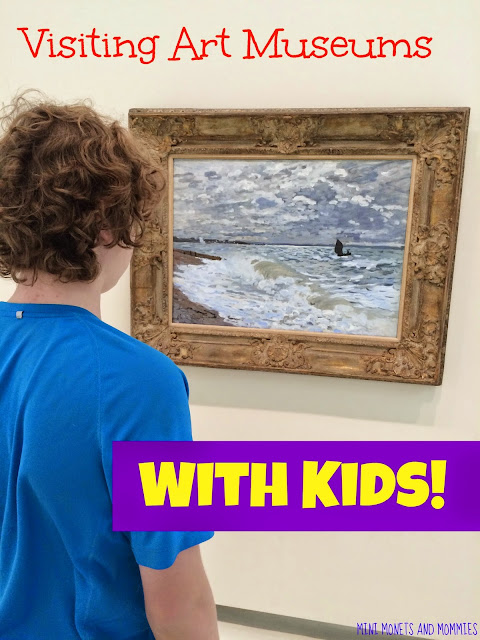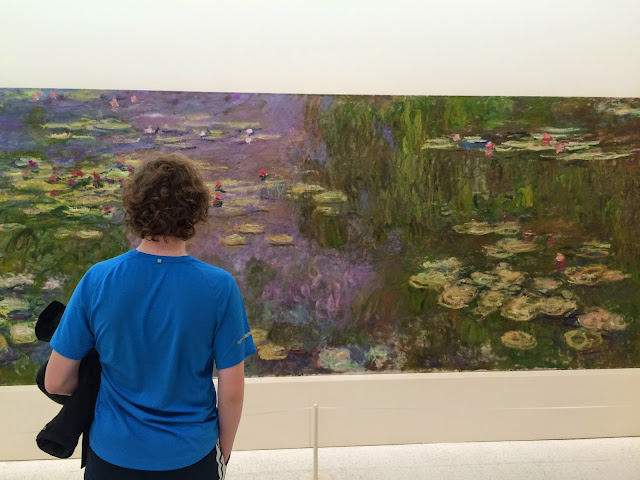I’ve spent a lot of time in art museums. After
teaching in art museums for the better part of the last decade, I’d looooove to
say that every parent should take their child to see real, authentic art. I’ve
written plenty on the subject, helping moms and dads to figure out what to look
at with their kids, how to look at it and what to talk about. Today I was
walking through the galleries of my local museum with my 13-year-old son. It
suddenly occurred to me that I’ve been going under a one-size-fits-all agenda
when it comes to viewing experiences.
Granted, when I have a group of 10 preschoolers or 20
third graders, I can’t tailor each question to each child. But, if I’m walking
around a gallery with my own child – I can. This doesn’t just apply to
eye-rolling teens (like my son), but to every child of every age. While starting
with basics or general questions is a great jumping-off point, building the discussion
around the child’s specific interests is key.
So, what does this look like in real life?
I’m going to suggest beginning with these basics:
1.What’s going on in this picture, painting, sculpture
or (insert any other type of artwork that you’re looking at here)?
-Why ask this? It gets your child
thinking. It’s the #1 question we always asked students visiting the museum. As
a museum teacher I used a method -- Visual Thinking Strategies -- that
facilitated discussion by starting off in this way. We always followed this
question with:
2. What do you see (in this picture) that makes you
say that?
-Why
ask this? It makes your child think even more. Think of this like a science exploration.
Your child makes a hypothesis and then observes carefully to tell you why she
thinks her prediction is correct. It’s an evidence-gathering activity. You can
prompt your child to go deeper by asking what else she can find.
For many kids, these few questions can really get them
talking. For others, not so much. My own son has always been one of these
not-so-much kind of kids. Well before he was too cool to go to the museum with
mom (i.e., before the tween/teen years), he was only marginally interested in
art. That’s ok. Not every kid is an art-lover. But, I did want to expose him to
more of the world than Thomas the Train had to offer (he was very much a
train-lover). I tried fun little scavenger hunt approaches to art viewing after
my typical open-ended questions failed to interest him. These worked out ok,
but not great.
Fast-forward to several years later and we are walking
through the art museum together as my son rolls his eyes yet again and says, “Are
we ready to leave yet?” No, we aren’t. I’m a notorious embarrassing picture
taker. I always, always make my son pose for photo ops. I spy Alberto
Giacometti’s “Walking Man” and beg my son to pose like the walking sculpture so
I can snap a picture. He eventually agrees.
As he’s standing next to the
sculpture he says, “You know, we had to do this in school during art class.” I
did not know that. He then proceeds to tell me what he thinks is a hilarious
story about his friend posing like the “Walking Man.” Before I knew it, he had
stop posing, was looking at the sculpture and was talking about it. He never
talks about art- so why now? Because he started the story, with a connection to
his own life.
We moved into the ‘ancient art’ gallery and looked at
an Egyptian relief. Instead of asking what he saw, I started with his social
studies class. I know that they extensively studied ancient civilizations.
Allowing him to bring his own interests, stories and world into the art opened
it up for him.

Your child doesn’t have to be a teen for this to work.
I started thinking about some of the conversations that I’ve had with
preschool-aged students at the museum. One of my favorite artworks is Monet’s “Water Lilies.” The kids do seem to enjoy viewing it, but some of the best
conversations that we’ve had have revolved around their own interests or their
own life stories. For example, I had a preschooler start talking about the lily
pad pond at her grandparents’ house and how that painting reminded her of it.
Another picked out his favorite colors in it, and then got more and more exuberant
(that’s code for jumping up and down and drawing the attention of more than one
of the museum’s security guards) as he pointed out the different hues.
How can you use this approach with your own child?
Pick an artwork that has something in it that you know
will spark her interest, attention or memory. It can be a setting, story,
character, color or anything else that you know will get her talking. For
example, has she been non-stop talking about a recent snowstorm? Take a look at
a snowy scene! Maybe you just got back from a trip to the beach? Look at an
ocean-themed artwork. Did she help you out in the garden? Visit an artwork that
shows plants and flowers. You can also pick artworks to look at that match
books she has recently read or themes from school. For example, if her pre-k
teacher is helping her to learn shapes, look for a geometric painting and let
her pick out the squares or rectangles.

You don’t have to wait until you take a trip to the
museum to look at art in this way. Use the basic open-ended questions, coupled
with specific ones based on your child’s interests, when you’re looking at
pictures in books or online. The key (at least for me) is connecting it to something
that sparks your child’s attention. There’s no parenting rule that says your
child has to view and discuss art by the great masters. If he’s totally into
trains, pick a painting with a cool choo choo in it. If your child carries her
new pet cat around 24-7, look for an artwork that features furry feline
friends. Bring the conversation to him instead of directing it at him. After
all, wouldn’t you rather talk about something that interests you?
Are you looking for art activities to go with your
viewing discussions? Follow my famous artists Pinterest board for ideas!
Follow Mini Monets and Mommies's board Famous Artist Kids' Activities on Pinterest.



























.JPG)
.JPG)
.JPG)
















